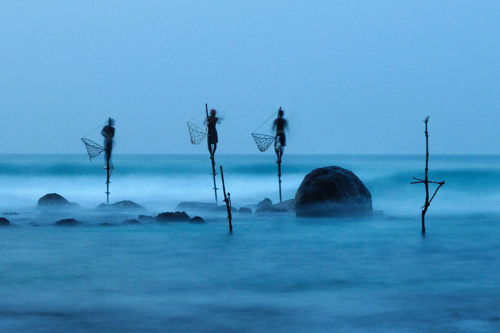
Notes from Howard's Sabbatical from Working. The name comes from a 1998 lunch conversation. Someone asked if everything man knew was on the web. I answered "no" and off the top of my head said "Fidel Castro's favorite color". About every 6-12 months I've searched for this. It doesn't show up in the first 50 Google results (this blog is finally first for that search), AskJeeves says it's: red.
Sunday, December 23, 2012
Darkened Cities

Friday, December 21, 2012
Antitrust was defined by Robert Bork. I cannot overstate his influence.
More Seriously About the NRA's Press Conference.
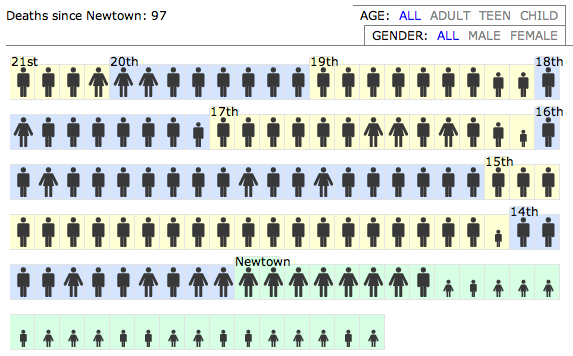 Stop The Shootings has more. The data is hard to come by. Two years ago the NY Times wrote N.R.A. Stymies Firearms Research, Scientists Say.
Stop The Shootings has more. The data is hard to come by. Two years ago the NY Times wrote N.R.A. Stymies Firearms Research, Scientists Say. "In the wake of the shootings in Tucson, the familiar questions inevitably resurfaced: Are communities where more people carry guns safer or less safe? Does the availability of high-capacity magazines increase deaths? Do more rigorous background checks make a difference?
The reality is that even these and other basic questions cannot be fully answered, because not enough research has been done. And there is a reason for that. Scientists in the field and former officials with the government agency that used to finance the great bulk of this research say the influence of the National Rife Association has all but choked off money for such work."
More recently JAMA wrote Silencing the Science on Gun Research. As Kevin Drum wrote "The conservative war on reality continues apace. If you don't like what's happening in the real world, simply defund anyone who tries to report on it. Mission accomplished!"
FactCheck.org in Gun Rhetoric vs. Gun Facts says: "The United States has the highest rate of gun ownership in the world — by far. And it has the highest rate of homicides among advanced countries. And yet, gun crime has been declining in the U.S. Firearm murders are down, as is overall gun violence – even as gun ownership increases. Read our Analysis for more insight on what these statistics mean."
Mother Jones offers, A Non-Gun-Owner's Guide to Guns.
WonkBlog explains, The NRA wants an ‘active’ mental illness database. Thirty-eight states have that now.
There was Disbelief in some quarters after NRA calls for armed guards at every school, blames movies
New York City Mayor Michael Bloomberg called the press conference "A Shameful Evasion Of The Crisis Facing Our Country".
New Jersey Gov. Chris Christie said armed guards are not the solution to ending school violence. “I don’t necessarily think having an armed guard outside every classroom is conducive to a positive learning environment.”
Boston Mayor Thomas Menino said "‘‘What they announced today is not a plan, but a ploy to bring more guns into our neighborhoods. I don’t believe the answer to gun violence is more guns.’’
The New Republic has particularly good commentary in The NRA's Emperor Has No Clothes.
Having Fun With the NRA's Press Conference
The NRA provided a pdf transcript of LaPierre's remarks. WonkBlog has a nice summary of the policy recommendations, Six ways the NRA would deal with gun violence.
Basically they want armed guards in every schools. "With all the foreign aid, with all the money in the federal budget, we can’t afford to put a police officer in every school?" FYI, at first glance he's right, there are about 100,000 public schools in the US, at $50K a year for a guard, that's $5 billion. The annual US foreign aid budget is a little under $30 billion. So even if they need 2 per school, the math works. Of course the aid does go to preventing people from starving and to eradicating disease and building up economies to make the world safer.
Here's some slightly different math saying it would come to $18 billion and "An annual license fee of about $75 per gun should adequately cover the expense of the NRA's proposal to put armed police officers at every K-12 school in the US."
He also says there should be a national database for the mentally ill and blames hollywood for movies and the violent video game industry.
Greg Sargent says the NRA resorts to its usual tricks: Obfuscation and distraction. "Keep in mind that all of this is deliberately designed to serve an overarching strategic goal — distraction. The NRA absolutely must keep the focus off of the problem of easy gun availability, and what can be done about it, for as long as possible."
Still it's so easy to have fun with this idiocy.
Igor Volsky pulls The 10 Craziest Quotes From The NRA Press Conference.
Gawker points out, While the NRA Was on TV Talking About the Need for More Guns Some Guy Was Walking Up and Down a Road in Pennsylvania Shooting People
Chris Hayes was pretty shocked by the press conference on twitter. Some of his better tweets and retweets:
NRA about to propose it seems, putting armed guards outside every school. This. Is. Horrifying.
Totally reasonable, sober proposal: a secret service detail for every school child in America. #omfg
TSA EVERYWHERE! #newnraslogans
NRA Executive Vice President Wayne LaPierre at one point said, "The only thing that stops a bad guy with a gun is a good guy with a gun." Hayes' comment: Good guys w/ guns vs bad guys w/ guns is, ironically, the moral cosmology of a small child.
Useful reminder: The first person Adam Lanza murdered owned a bunch of guns.
Some others:
Chase Mitchell: Just want to point out the NRA's plan to stop school shootings is literally the plot of Kindergarten Cop.
Seth Meyers: NRA: If we banned schools there would never be another school shooting.
Michael Ian Black: Oh cool, George Zimmerman is going to be protecting my kids in school.
Michael Ian Black: When somebody shoots up a dentist's office, they'll be advocating for armed dental hygienists.
Bob Schooley: If only Ft. Hood had armed, trained security personnel.
Ana Marie Cox: WHY STOP AT ARMED GUARDS IN SCHOOLS? That's the question. Personal security, around the clock, for everyone, everywhere. It's our only hope.
Ana Marie Cox: LaPierre insisting that this armed-guards everywhere strategy is "proven." And it's true military states have lower rates of street crime.
Catherine Rampell: N.R.A. Calls for Armed Guards in Schools to Deter Violence http://nyti.ms/Yu6pon there was an armed guard at Columbine.
Lawrence Lessig: Ah yes, the problem isn't the 2d A, it's the 1st A. "NRA blames Hollywood
Alex Bowles follows: Meanwhile, back in Canada—where you find all the same movies and games—the most violent thing to happen regularly is hockey.
Jay Rosen: Exact quote just now from the NRA press conference. "This is the beginning of a serious conversation. We won't be taking any questions."
Ezra Klein: So tracking private gun sales is an unconscionable assault on liberty but we can have a national database of the mentally ill.
I will point out that he edited that for maximum effect. The full statement by NRA President Dave Keene at the end of the conference was: "This is the beginning of a serious conversation. We won't be taking questions today but, Andrew Arulanandam, our public affairs officer, is here. We will be willing to talk to anybody beginning on Monday."
Matt Seaton: This NRA presser is not train wreck. It's an asteroid impact. Media profs will be teaching it for years as epic 'how not to' do crisis comms
Thursday, December 20, 2012
Best Nature Pictures of 2012
Insanely stunning photos. You've got some pollen on your butt...

Choose your own fiscal cliff adventure!
Here's my fiscal cliff solution .
Back to the Grind: George Howell Coffee
I live in walking distance to his current cafe and I go all the time. They usually do tastings Monday evening at 6:30p and George usually starts with a brief presentation on some aspect of coffee (it's mostly training for the staff but others are welcome).
Wednesday, December 19, 2012
The Most Popular Explainers of 2012
Unofficial FIrefly Lego Set
This playset has an interesting history. Originally the design was put up on the LEGO CUUSOO site with the possibility of becoming an actual LEGO branded product with a required 10,000 votes. After just a couple of months, in what must have been some sort of speed record, all votes were obtained and success seemed imminent. Much to the chagrin of supporters everywhere, the playset did not pass LEGO's review, despite recognition, praise, and visibility from a bunch of websites, Wired.com, retweets from 3 of the show's actors & Grant Imahara. That was the end...or so everyone thought.
Steps have been taken to ensure that this model finally will be available for all. While not an official LEGO set, this is being provided as a service to find & source all the bricks required to put this together, along with the instructions and a few other surprises. Spend your time building the model, not sourcing and waiting for all the parts to come. Instead, get a box of parts in the mail, ready to build."
Best Astronomy Images 2012

"Every December I pick my favorite images from the previous year to display, a task that is extraordinarily difficult. I always wind up with a list of about 60 or 70, and I have to cull it down mercilessly. Such is the case this year again, and I could pare it only to 21, a score and more of gorgeousness for you to soak in. I choose the pictures not just for their beauty but also because they are interesting, and different—ones that stand out from the crowd somehow. I usually put them in order with my favorite one last, but this year I just can’t. I’ll let you know my favorite when you get to it—I expect you’ll agree—but other than that it’s just a dead tie."
The Curious Case of the Silent Filibuster
I learned a few things.
Space Station Tour
He wrote: "When I clicked this, I figured I’d watch for a minute or two … and found myself watching the whole thing, because it was simply fascinating." and that was absolutely true for me too.
Some things I learned:
The exercise bike isn't firmly attached to the wall to prevent forces from being exerted on the structure of the station.
There's marshmallow fluff on the ISS.
Spacesuits weigh about 300 lbs.
There's a wide variety of toilet paper.
Everything looks like a mess (but probably is very well organized).
The seats in a Soyuz capsule are hand molded to each individual.
The Brain: The Charlie Brown Effect
A Visual History of Nobel Prizes and Notable Laureates, 1901-2012
I don't know why it's on an angle.

Guns
Paul Waldman: Ten Arguments Gun Advocates Make, and Why They're WrongDo Armed Civilians Stop Mass Shooters? Actually, No. "Five cases commonly cited as a rationale for arming Americans don't stand up to scrutiny."
Constitutional scholar Akhil Reed Amar: Putting the Second Amendment Second
WonkBlog: Everything you need to know about the assault weapons ban, in one post ""
WonkBlog: How the U.S. gun industry became so lucrativeHow Walmart Helped Make Newtown Shooter's AR-15 the Most Popular Assault Weapon in America
Jill LePore: Trayvon Martin and America's Gun Laws
Nate Silver: Party Identity in a Gun Cabinet
Erik Larson from 1993: The Story of a Gun
The 15 Most Dangerous People in the World
Outrageous HSBC Settlement Proves the Drug War is a Joke
"[Assistant Attorney General Lanny] Breuer this week signed off on a settlement deal with the British banking giant HSBC that is the ultimate insult to every ordinary person who's ever had his life altered by a narcotics charge. Despite the fact that HSBC admitted to laundering billions of dollars for Colombian and Mexican drug cartels (among others) and violating a host of important banking laws (from the Bank Secrecy Act to the Trading With the Enemy Act), Breuer and his Justice Department elected not to pursue criminal prosecutions of the bank, opting instead for a 'record' financial settlement of $1.9 billion, which as one analyst noted is about five weeks of income for the bank."
"Though this was not stated explicitly, the government's rationale in not pursuing criminal prosecutions against the bank was apparently rooted in concerns that putting executives from a "systemically important institution" in jail for drug laundering would threaten the stability of the financial system…It doesn't take a genius to see that the reasoning here is beyond flawed. When you decide not to prosecute bankers for billion-dollar crimes connected to drug-dealing and terrorism (some of HSBC's Saudi and Bangladeshi clients had terrorist ties, according to a Senate investigation), it doesn't protect the banking system, it does exactly the opposite. It terrifies investors and depositors everywhere, leaving them with the clear impression that even the most "reputable" banks may in fact be captured institutions whose senior executives are in the employ of (this can't be repeated often enough) murderers and terrorists. Even more shocking, the Justice Department's response to learning about all of this was to do exactly the same thing that the HSBC executives did in the first place to get themselves in trouble – they took money to look the other way."
"As a result of the government's investigation, HSBC has . . . "clawed back" deferred compensation bonuses given to some of its most senior U.S. anti-money laundering and compliance officers, and agreed to partially defer bonus compensation for its most senior officials during the five-year period of the deferred prosecution agreement."
He then compares the penalty of the executives (though only the second part of it) to those suffered by non-violent small amount drug users. It seems a very fair point.
"They're now saying that if you're not an important cog in the global financial system, you can't get away with anything, not even simple possession. You will be jailed and whatever cash they find on you they'll seize on the spot, and convert into new cruisers or toys for your local SWAT team, which will be deployed to kick in the doors of houses where more such inessential economic cogs as you live. If you don't have a systemically important job, in other words, the government's position is that your assets may be used to finance your own political disenfranchisement.
On the other hand, if you are an important person, and you work for a big international bank, you won't be prosecuted even if you launder nine billion dollars. Even if you actively collude with the people at the very top of the international narcotics trade, your punishment will be far smaller than that of the person at the very bottom of the world drug pyramid. You will be treated with more deference and sympathy than a junkie passing out on a subway car in Manhattan (using two seats of a subway car is a common prosecutable offense in this city). An international drug trafficker is a criminal and usually a murderer; the drug addict walking the street is one of his victims. But thanks to Breuer, we're now in the business, officially, of jailing the victims and enabling the criminals."
If you want something (slightly) calmer on the topic William Black has three pieces: Why Did Obama and Cameron Save a Criminal Enterprise Like HSBC?, Did Obama and Cameron Require HSBC to Aid the Prosecution of Tax Frauds? and 4 Insane Ideas Behind Obama's and Cameron's Decision That HSBC's Officers Should Be Immune From Prosecution
Saturn Splendor Seldom Seen

Best and Worst Science Fiction/Fantasy Movies of 2012
100 Riffs (A Brief History of Rock N' Roll)
CHART: All the fiscal cliff offers and counteroffers
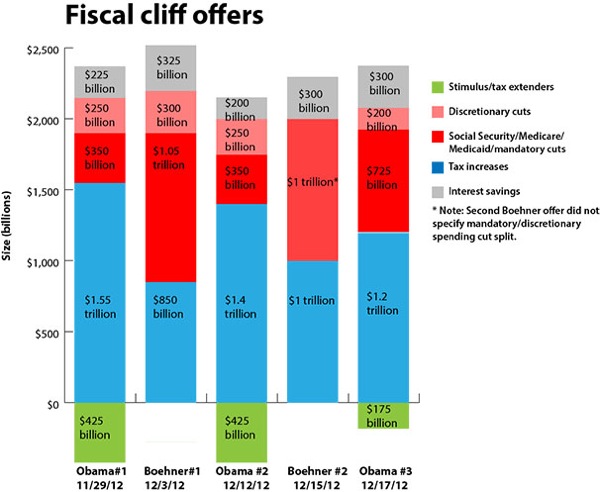
Saturday, December 15, 2012
Do We Have the Courage to Stop This?
Gruber has a inboard of other good articles.
ProPublica has a good list of older articles. "In the wake of last week's shooting in Aurora, Colo., we've taken a step back and laid out the best pieces we could find about guns. They're roughly organized by articles on rights, trafficking and regulation."
Global mortality and causes of death visualised
"What diseases and injuries cause the most death and disability globally? Compare how each cause affects specific age groups or regions in terms of death and disability. You can change age group or region, year, and metric to view results for absolute numbers, rates, and percentages. You also have the option to further explore each cause group and view specific diseases, injuries, or risk factors - click the navigation buttons at the top of the chart to use it"
You can look at the data a bunch of different ways but this was most interesting to me:

Think you know all there is to know about paper snowflakes?
Google Maps for iPhone
Here's a hack to Get Siri to use Google Maps for directions.
2012: The Year in Volcanic Activity

Standing and Delivering
7 Secret Ways America's Stealth Armada Stays Off the Radar
These other stealth enhancements include: chemicals to eliminate telltale contrails; sophisticated, untraceable sensors and radios; specially designed, hard-to-detect engine inlets; radar-canceling paint; and cooling systems for reducing a plane's heat signature. All of these evasion methods have been disclosed by the Air Force, although sometimes in scant detail."
Everything you need to know about Chained CPI in one post
Thursday, December 13, 2012
Zeitgeist 2012
I predict next year will be topped by searches about Kate Middleton's baby.
Wednesday, December 12, 2012
Tim Cook's Freshman Year: The Apple CEO Speaks
Essential Star Trek Novels That Even Non-Trekkers Should Read
I had only a few Star Trek Novels as a kid but the first two on the list (Spock Must Die and Planet of Judgement) were among them. I haven't read the rest and I'm curious if any of you have and found them good.
Tuesday, December 11, 2012
Amazon To Collect MA Sales Tax Next Fall
It will cost, but it's only fair. More fair would be if all online retailers paid sales tax. Though I'm not sure how that should work. Where the products ship to was my first thought but that fails for buying services and is a little odd for gifts. Address of the buyer makes more sense, though I could then see a nice industry of credit cards with addresses that are PO Boxes on Caribbean islands. With online statements the street address registered with a credit card seems vestigial.
Saturday, December 08, 2012
The Changing Structure of Prices since 1960

Rise of the Robots
"Catherine Rampell and Nick Wingfield write about the growing evidence for ‘reshoring’ of manufacturing to the United States. They cite several reasons: rising wages in Asia; lower energy costs here; higher transportation costs. In a followup piece, however, Rampell cites another factor: robots.
Robots mean that labor costs don’t matter much, so you might as well locate in advanced countries with large markets and good infrastructure (which may soon not include us, but that’s another issue). On the other hand, it’s not good news for workers!"
A 3D printer that manufactures new cancer drugs with drag-and-drop DNA
"Researchers from Parabon NanoLabs have developed a new drug for combating a lethal brain cancer called glioblastoma multiforme. But what makes this particular drug unique is that it was printed — molecule by molecule — using a DNA self-assembly technique. And even more remarkable is that the DNA was custom designed with a drag-and-drop computer program. The breakthrough will not only drastically reduce the time it takes to both create and test medications, it will also open the door to completely novel drug designs."
World's Biggest Tsunamis Threaten Hawaii
"It's almost unimaginable: a tsunami more than 1,000 feet (300 meters) high bearing down on the island of Hawaii.
But scientists have new evidence of these monster waves, called megatsunamis, doing just that. The findings were presented here yesterday (Dec. 5) at the annual meeting of the American Geophysical Union.
Unlike tsunamis from earthquakes, the Hawaiian tsunamis strike when the island chain's massive volcanoes collapse in humongous landslides. This happens about every 100,000 years, and is linked to climate change, said Gary McMurtry, a professor at the University of Hawaii in Honolulu."
Into The Vault: The Operation To Rescue Manhattan's Drowned Internet
"Levendos explains to me that before crews could even begin removing water, they needed to repair ground-level fuel pumps to feed backup diesel generators on the upper floors. Two mobile generator trailers were brought in, and they remained in use when I visited, as local power utility Con Ed worked to reconnect the building to the grid. Workers then used trucks to pump dry air through the copper wiring — a job that’s typically handled by air pumps in the basement that were rendered useless by the storm surge. It was too late for the decades-old copper wiring, which was submerged for the better part of two days. After crews sent test signals into the copper, Levendos says he was 'left with the conclusion here that much of what is around me has been destroyed.'
Miles of copper is ruined not only in the cable vault at Broad Street, but also at 20 or so manholes around the area. Even worse, paper insulation in the copper wiring sucks water through the cabling from capillary action, destroying cabling even in dry areas. Levendos says it’s 'far too tedious, time consuming, and not effective of a process to try and put this infrastructure back together,' so Verizon’s taking the opportunity to rewire with fiber optics instead. Service has been restored to FiOS customers for over a week — unlike copper, fiber optics aren’t damaged by the water. As part of this process, crews have already pulled fiber up the major corridors — including Water, Broad, and Pearl Streets — to ultimately connect the fiber network to buildings."
A Minimum Tax for the Wealthy
"Suppose that an investor you admire and trust comes to you with an investment idea. ‘This is a good one,’ he says enthusiastically. ‘I’m in it, and I think you should be, too.’ Would your reply possibly be this? ‘Well, it all depends on what my tax rate will be on the gain you’re saying we’re going to make. If the taxes are too high, I would rather leave the money in my savings account, earning a quarter of 1 percent.’ Only in Grover Norquist’s imagination does such a response exist."
British have invaded nine out of ten countries - so look out Luxembourg - Telegraph

Trends in U.S. Military Spending
There are a lot of good charts here, the first one is telling:

This one is perhaps too busy, but it's a summary of three charts that they described previously:
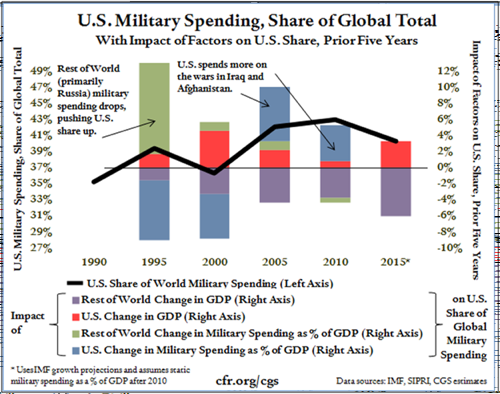
And some perspective:

Many more on the page.
The single best graph on what’s driving our deficits
"That’s all of the federal government’s spending in three graphs. The top graph is health care, including Medicare, Medicaid and the Affordable Care Act. The middle graph is Social Security. And then there’s literally everything else: Defense, education, infrastructure, food safety, R&D, farm subsidies, the FBI, etc.
What these three charts tell you is simple: It’s all about health care. Spending on Social Security is expected to rise, but not particularly quickly. Spending on everything else is actually falling. It’s health care that contains most all of our future deficit problems. And the situation is even worse than it looks on this graph: Private health spending is racing upwards even faster than public health spending, so the problem the federal government is showing in its budget projections is mirrored on the budgets of every family and business that purchases health insurance."

Earth at Night

And while I usually find these videos not all that informative, this one is short and pointed out some interesting things in the image that might well have missed…
The History of Film by HistoryShots
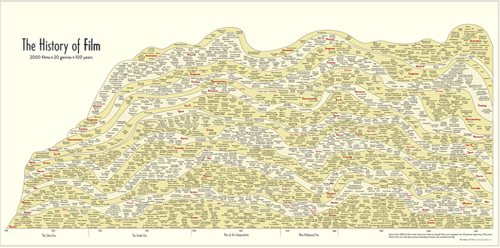
Drone Strikes: Map Shows Pakistan Drone Strikes

"In June Slate published a map, based on data from the New America Foundation, showing the locations and kill estimates of reported drone strikes in Pakistan, where most of the drone strikes occur. Since that map was published, the media have reported 22 more, for a total of 284. The map above includes these additional strikes."
Friday, December 07, 2012
Jon Stewart and Chris Christie
Last night Stewart had Christie on, and to Stewart's credit, he brought it up with Christie. Unfortunately it took until the third (and unaired) segment to get an answer. Here's that third part and it's not a bad conversation, though it still skirts around the tone of politics too much.
Thursday, December 06, 2012
The United States (Code) is on Github
Mitch McConnell Filibuster's His Own Bill
2012: The Year in Photos

Why the GOP Won't Admit Supply-Side Econ Has Failed
"In fact, the Bush tax cuts can be thought of as a loan from the Social Security Trust Fund that was supposed to be paid back with the revenues from higher economic growth, a loan that is presently in default.
To see this, recall that the government began intentionally collecting a surplus from the Social Security program beginning in 1983 in order to prefund the retirement needs of baby boomers. The idea was to run a surplus for several decades while the baby-boomers were still working to get ready for the deficit years the system would experience after they retired.
The revenue from Social Security over and above what was needed to fund payouts reduced the overall government debt and allowed taxes to be lower than they could have been without these surplus funds. For example, the surplus that Bush inherited from the Clinton administration was largely due to the Social Security Trust Fund, and Bush argued it would be better to give this surplus to the private sector through tax cuts than to leave it in the hands of the government.
But it wasn’t better. The income of the wealthy grew as they pocketed the tax cuts, but workers experienced stagnant wages, a recession that hit working class households particularly hard, and intense pressure to cut important social programs."
Green Grow the Grassroots
Three-Card Budget Monte
"It goes without saying that the Republican “counteroffer” is basically fake. It calls for $800 billion in revenue from closing loopholes, but doesn’t specify a single loophole to be closed; it calls for huge spending cuts, but aside from raising the Medicare age and cutting the Social Security inflation adjustment — moves worth only around $300 billion — it doesn’t specify how these cuts are to be achieved. So it’s basically the Paul Ryan method: scribble down some numbers and pretend that you’re a budget wonk with a Serious plan.
What I haven’t seen pointed out here is the longer arc of GOP strategy. Does anyone recall how the Bush tax cuts were passed? The 2001 cut was passed based on the claim that the government was running an excessive surplus; the 2003 cut on the claim that it would provide an economic boost. Then the surplus went away, and the economy did not, to say the least, perform very well.
So now we face a substantial long-run deficit largely created by those tax cuts:
And the GOP says that because of that deficit we must raise the Medicare age and cut Social Security!
Oh, and for all the seniors or near-seniors who voted Republican because you thought they would protect Medicare from that bad guy Obama: you’ve been had."
The Full McConnell
"In his interview with the Wall Street Journal, Mitch McConnell finally mentioned a few sort-of specifics about what spending cuts the GOP wants: raising the Medicare age, charging higher premiums to affluent Medicare recipients, and changing the price indexing of Social Security. But how much does all this amount to?"
"So, if we take all of McConnell’s ideas together, we get a bit more than $300 billion. Getting this would, by the way, impose substantial hardship – seniors would be forced into inferior private insurance, and there are good reasons to believe that the true inflation rate facing seniors is actually higher, not lower, than the CPI. Still, what we’re looking at overall is a saving equal to only about one-fifth of what Obama is proposing to raise by higher taxes."
"This is pathetic – and these people are definitely not serious."
Later he reiterates, It’s Health Care Costs, Stupid.
"The point is that if you want to control Medicare costs, you can’t do it by kicking a small number of relatively young seniors off the program; to control costs, you have to, you know, control costs. And the truth is that we know a lot about how to do that — after all, every other advanced country has much lower health costs than we do, and even within the US, the VHA and even Medicaid are much better at controlling costs than Medicare, and even more so relative to private insurance."
"But even as Republicans demand “entitlement reform”, they are dead set against anything like that. Bargaining over drug prices? Horrors! The Independent Payment Advisory Board? Death panels! They refuse to contemplate using approaches that have worked around the world; the only solution they will countenance is the solution that has never worked anywhere, namely, converting Medicare into an underfunded voucher system."
Cliff Notes on the Three Real Perils Ahead
The child poverty cliff.
Between 2007 and 2011, the percentage of American school-age children living in poor households grew from 17 to 21%. Last year, according to the Agriculture Department, nearly 1 in 4 young children lived in a family that had difficulty affording sufficient food at some point in the year.
Yet federal programs to help children and lower-income families – food stamps, aid for poor school districts, Pell grants, child health care, child nutrition, pre- and post-natal care, and Medicaid – are being targeted by the Republican right. Over 60 percent of the cuts in the GOP’s most recent budget came out of these programs.
The baby-boomer healthcare cliff.
Healthcare costs are already 18% of GDP. Between now and 2030, when 76 million boomers join the ranks of the elderly, those costs will soar. This is the principal reason why the federal budget deficit is projected to grow.
But we can’t avoid the fact we have the most expensive and least effective system of health care in the world that’s spending 30 percent more on paperwork and administration than on keeping people healthy. The real healthcare cliff can only be avoided if we adopt a single-payer healthcare system.
The environmental cliff.
Global emissions of carbon dioxide jumped 3 percent in 2011 and are expected to jump another 2.6 percent this year according to scientists, putting the human race perilously close to the tipping point when ice caps irretrievably melt, sea-levels rise, and amount of available cropland in the world becomes dangerously small.
Yet Republicans (and their patrons, such as Charles and David Koch) continue to deny climate change. And the Administration is no longer pushing for a cap-and-trade system or a carbon tax.
'Necessary,' 'Proper,' and Health Care Reform
I haven't read this yet, but the abstract looked interesting (to me at least).
"Chief Justice John Roberts argued, in NFIB v. Sebelius, that the Affordable Care Act exceeded Congress’s commerce power. The individual mandate to purchase insurance was not authorized by the Necessary and Proper Clause, he reasoned, because it involved a ‘great substantive and independent power.’ He did not explain how one could tell what constituted such a power. This limitation was worked out in more detail by amici, and Roberts may have been gesturing toward their argument. This essay will look to the antecedents of Roberts’s argument to try to make better sense of what he said. This strategy will fail. There is no way to make this argument look good. It is a placeholder for a raw intuition that the law’s trivial burden on individuals was intolerable, an outrageous invasion of liberty, even when the alternative was a regime in which millions were needlessly denied decent medical care."
The Fiscal Cliff
The White House’s fiscal cliff proposal.
Obama to GOP: I’m done negotiating with myself.
"That’s what you’re really seeing in this “proposal.” Previously, Obama’s pattern had been to offer plans that roughly tracked where he thought the compromise should end up. The White House’s belief was that by being solicitous in their policy proposals, they would win goodwill on the other side, and even if they didn’t, the media would side with them, realizing they’d sought compromise and been rebuffed. They don’t believe that anymore.
Perhaps the key lesson the White House took from the last couple of years is this: Don’t negotiate with yourself. If Republicans want to cut Medicare, let them propose the cuts. If they want to raise revenue through tax reform, let them identify the deductions. If they want deeper cuts in discretionary spending, let them settle on a number. And, above all, if they don’t like the White House’s preferred policies, let them propose their own. That way, if the White House eventually does give in and agree to some of their demands, Republicans will feel like they got one over on the president. A compromise isn’t measured by what you offer, it’s measured by what the other side feels they made you concede."
The best idea in American politics: Kill the debt ceiling begins with a good explanation of Obama's opening bid, particularly relating it to the Budget Control Act of 2010.
"That gives the structure of the White House’s proposed deal an evident symmetry: Republicans won in 2010, and they leveraged that win to secure the roughly $1 trillion in cuts in the Budget Control Act. Democrats won in 2012, and they intend to leverage that win to secure the roughly $1 trillion in revenue from the expiration of the high-end Bush tax cuts. After that’s done, the White House is proposing another $600 billion in spending cuts and another $600 billion in tax increases. Add in the $1 trillion or so in expected savings from ending the wars, and you’ve got about $4.2 trillion in deficit reduction over 10 years. Add in the savings on expected interest payments and you’re at almost $5 trillion. Subtract the White House’s stimulus request, and you’re somewhere a bit north of $4.5 trillion. That’s their opening bid. "
"But that’s not all: There’s also a proposal to end debt-ceiling crises forevermore. The idea comes from a most unlikely source: Senate Minority Leader Mitch McConnell (R), who proposed in July 2011 to permit the president to unilaterally raise the debt ceiling unless Congress affirmatively voted to stop him. And even if Congress did vote to stop him, the president could veto, and then Congress would need to overturn his veto."
How Obama would cut Medicare spending in a deficit deal
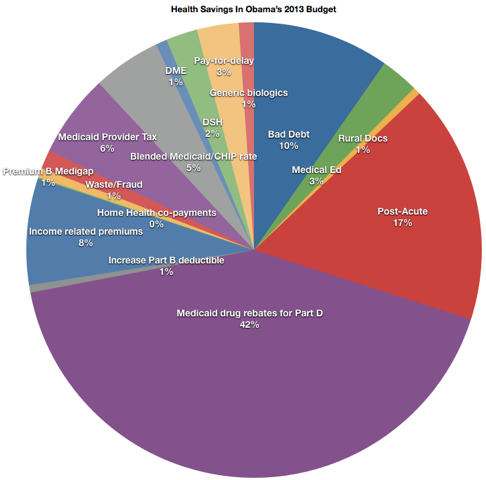 Boehner’s new counterproposal.
Boehner’s new counterproposal. Boehner’s latest tax offer is $150 billion less than he offered in 2011.
"Boehner’s offer from a year ago was meant to be roughly equal to the cost of letting the high-income Bush tax cuts lapse in 2013. But because we measure these things in the “10-year budget window,” the revenue was measured from 2012-2021. Thus, the revenue target Boehner was trying to reach included 2012, which was a year when the tax cuts were expected to be kept in place. So though the offer was for a 10-year plan, he was really offering revenue equal to only nine years of letting the tax cuts lapse. That reduced the total revenue he had to raise. Now, since he has to pay for the expiration of the tax cuts for the full 10 years, a revenue offer equal to the cost of the high-income tax cuts needs to raise about $950 billion, not $800 billion."
Boehner tries to call a mulligan.
"It is not surprising that Boehner wishes he could go back in time and accept the president’s offer from 2011, or fight for the compromise Bowles outlined before the supercommittee. Those are, from his vantage point today, quite good deals. But elections have consequences, and the consequence of this election is that those offers are no longer on the table.
Instead, we are likely to see a slow process of Bowles-style, split-the-difference compromise. Boehner is now at $800 billion in revenues, and the White House is at $1.6 trillion. If the two sides end at $1.2 trillion, that would be about what most in Washington are expecting. Similarly, Boehner is at $900 billion in mandatory spending cuts, and Obama is at $600 billion. if the two sides end at $750 billion, that wouldn’t be such a surprise. "
Today in ‘fiscal cliff’: This is what progress looks like.
"President Obama says it’s “out of balance.” The Heritage Foundation says it’s “preemptive capitulation.” But the reactions on both left and right drive home the fact that House Speaker John Boehner’s proposal to stop the “fiscal cliff” marks some progress in the ongoing negotiations, ending the standoff that’s been casting gloom over Washington over the last few days."
"On spending and entitlements, it’s not entirely clear what Boehner is asking for, aside from a $900 billion target, as simply raising the Medicare age, for instance, wouldn’t save nearly enough money. But the few details that Republican aides offered—notably, on background—have already prompted some signs of movement on the Democratic side. Despite earlier calls by Democrat leadership to take Social Security out of the discussions entirely and leave Medicare and Medicaid largely intact, House Democratic Whip House Steny Hoyer (Md.) told reporters Tuesday morning that Boehner’s proposals to limit the growth of Social Security benefits, raise Medicare premiums for the wealthy, and raise the Medicare eligibility age are a part of the negotiations."
The GOP’s bizarre ‘doomsday plan’.
"Republicans are seriously considering a Doomsday Plan if fiscal cliff talks collapse entirely. It’s quite simple: House Republicans would allow a vote on extending the Bush middle class tax cuts (the bill passed in August by the Senate) and offer the President nothing more: no extension of the debt ceiling, nothing on unemployment, nothing on closing loopholes. Congress would recess for the holidays and the president would face a big battle early in the year over the debt ceiling. Two senior Republican elected officials tell me this doomsday plan is becoming the most likely scenario.
Today, the New York Times adds more detail, including this quote from Rep. Michael C. Burgess (R-TX): “There’s always better ground, but you have to get there.” In this case, the “better ground” is exchanging the threat of a congressionally induced recession for the threat of a congressionally induced global financial crisis. That’s better ground?"
"Meanwhile, Republicans will be threatening not just to take us over the fiscal cliff, which will already have happened, but to trigger a financial crisis by breaking through the debt ceiling. And they will be doing all of this after having lost an election. And for what? Because they want deeper Medicare cuts that they refuse to publicly specify? "
Today in ‘Fiscal Cliff’: If the GOP folds on taxes, what would Dems give up in return?.
"Democrats won’t compromise on tax hikes for the wealthiest 2 percent of Americans. And there are signs that this hard-line strategy may be working: Today, Sen. Tom Coburn (R-Okla.) became the latest Republican to say that he’d be open to increases in marginal tax rates to raise revenue.
It isn’t the first time that Coburn, a Gang of Six member, has bucked GOP orthodoxy on taxes. But he joins the growing ranks of conservatives who say that it’s not worth the fight on upper-income tax rates, signaling that Republicans may ultimately concede the issue to Democrats.
As that reality has begun to sink in, there’s been a lot more talk about about how Republicans can best position themselves and what they might demand in exchange for increases in tax rates, assuming that they have lost that battle. That raises the question of what Democrats would be willing to concede in return."
There are other plans on the table too:
Bill Clinton’s people brought down the deficit once. Now they’re trying to do it again..
"On Tuesday, CAP unveiled a tax reform plan written by a rogue’s gallery of Clinton vets, including former treasury secretaries Robert Rubin and Larry Summers, deputy treasury secretary Roger Altman, White House chief of staff John Podesta, commerce secretary Bill Daley and others. Summers and Daley, as well as report co-author and CAP president Neera Tanden, all held high-ranking posts in the Obama administration.
The $4 trillion deficit-reduction plan the group came up with raises $1.8 trillion in new revenue through tax reform, $1.5 trillion through enforcing existing budget caps, and $485 billion in cuts to Medicare and defense spending. It adds $400 billion in stimulus and infrastructure investments meant to help growth. If implemented, that proposal would get debt-to-GDP down to 72 percent in 2022, or about where it is today. The importance of that measure is highly questionable, but insofar as one wants deficit reduction, the plan accomplishes that goal. The Medicare and defense cuts come from existing CAP plans, but the tax stuff is all new."
11 shocking, true facts about Simpson-Bowles.
"An important fact to keep in mind in the coming days: “The Bowles plan” that Speaker John Boehner endorsed is not the same as “the Simpson-Bowles plan.” Indeed, it’s not even the plan supported by its apparent namesake, Erskine Bowles, who insists that he was simply sketching out the evident middle ground between the members of the supercommittee.
The Simpson-Bowles plan — which Erskine Bowles does actually support — occupies strange territory in Washington: Almost every politician professes to admire it, almost none of them are willing to vote for it, and almost none of its supporters know what’s in it. So here, with an assist from the Center on Budget and Policy Priorities, are a few facts to keep in mind about the Simpson-Bowles plan. And while you’re reading this list, remember: Simpson-Bowles is a centrist proposal."
Here are the three that really jumped out at me:
"2) There are a lot of tax increases in Simpson-Bowles. $2.6 trillion over 10 years, to be exact. That’s more than President Obama ever proposed. It’s way more than the Republicans have ever proposed. It’s $1.8 trillion more than in the “Bowles plan” that Boehner is proposing. Think about that: To follow the Simpson-Bowles recommendation on taxes, you’d have to take the $800 billion Boehner is proposing and then raise taxes by more than the $1.6 trillion Obama is asking for."
"8) Simpson-Bowles cuts security spending by $1.4 trillion, not including drawing down the wars. That’s far deeper than what’s in the law now, far deeper than anything the White House or the Republicans have proposed, and deeper, I believe, than the sequester cuts that so many think would devastate the military."
"9) The Social Security changes. Simpson-Bowles makes three main changes to Social Security. It increases the taxable maximum on income to 90 percent of all income, which raises $238 billion over the next decade. It uses a different measure of inflation to slow cost-of-living adjustments. It raises the retirement age to 68 in 2050 and 69 in 2075"
A few things to keep in mind when you hear all these plans.
I think Ezra Klein is the only journalist that writes (and interestingly) about budget baselines, but that's exactly what he does in The GOP’s hidden budget advantageRaising Medicare’s age: Saves feds $5.7 billion, costs you $11.4 billion.
" If the Medicare age were raised, the thinking has gone, the 3.3 million 65- and 66-year-olds would still be guaranteed access to health coverage through the tax subsidies. The lowest-income seniors — those earning less than 133 percent of the federal poverty line – would qualify for Medicaid.
That’s the upside. Health care economists see a number of downsides, too. For one thing, Medicare tends to be a pretty efficient program. Its costs have grown slower than private health insurance plans. The Center for Budget Priorities and Policy estimates that, while the federal government would save $5.7 billion, the rest of the health care system would end up spending $11.4 billion more to provide those same benefits."
 The reality of tax reform: Less charity, smaller homes, higher state taxes. "The term ”base-broadening, rate-lowering tax reform” has the advantage of vagueness: No one knows what it means. But the practical definition, at least the one that’s emerging in the ongoing “fiscal cliff” negotiations, is tax reform that limits itemized deductions among high-income taxpayers. And as former OMB director Peter Orszag points out, 90 percent of the value of those deductions comes from just three categories: “taxes paid (mostly state and local taxes), home-mortgage interest and charitable contributions.” So when we say “base-broading, rate-lowering tax reform,” here’s what we’re really saying: Tax reform that’s paid for by cutting tax breaks for charities, homes, and state and local taxes."
The reality of tax reform: Less charity, smaller homes, higher state taxes. "The term ”base-broadening, rate-lowering tax reform” has the advantage of vagueness: No one knows what it means. But the practical definition, at least the one that’s emerging in the ongoing “fiscal cliff” negotiations, is tax reform that limits itemized deductions among high-income taxpayers. And as former OMB director Peter Orszag points out, 90 percent of the value of those deductions comes from just three categories: “taxes paid (mostly state and local taxes), home-mortgage interest and charitable contributions.” So when we say “base-broading, rate-lowering tax reform,” here’s what we’re really saying: Tax reform that’s paid for by cutting tax breaks for charities, homes, and state and local taxes."IMF: Budget cuts hurt growth a lot. But tax increases barely matter..
"A new study (pdf) by the International Monetary Fund raises a further warning flag for fiscal cliff negotiators in the U.S. In what it bills as the first-ever study of its kind, the fund analyzed decades of data on the world’s major industrialized countries to estimate how changes in government spending or revenue affect economic output."
"Given current circumstances, with a U.S. economy that is growing but still trying to make up lost ground from the 2008 crisis, a one dollar change in government spending could knock as much as $1.80 in output from the economy – what fund researchers called a “statistically significant…and sizeable” outcome.
One brighter spot that could also influence negotiators: the growth impact of a tax hike is estimated to be negligible. The list of measures that automatically become law absent an agreement include both spending reductions and tax increases. While the spending cuts would comprise a heavy drag on growth, the fund paper suggests that a one percent rise in tax revenue would knock just 0.1 percent from gross domestic product."
“Person of the Year” Nomination for Higgs Boson Riddled with Errors
Skynet Countdown
iRobot Founder Now Building Tiny Hovering Drone Spies.
The first is Ease, or “Extreme Access System for Entry.” Really, it’s a tiny hover-bot designed for “intelligence, surveillance, and reconnaissance.” And it’s small enough — it only has a 1-foot diameter and a height of 16 inches from top to bottom – to fly through windows and maneuver through buildings with its ducted fan engine. In a video released by the company, the Ease can be seen hovering through an abandoned-looking building to a psychedelic funk soundtrack. It can also theoretically stay in the air forever.
The reason is that instead of communicating wirelessly, the drone receives instructions and power through a microfilament cord of spooled copper the width of a fishing line and connected to the robot’s ground control station. And because it’s plugged in directly, the Ease drone should be harder to hack than other drones.
The other new drone is the Parc, or “Persistent Aerial Reconnaissance and Communications.” Like Ease, it also hovers. But the Parc is designed to fly high and for long periods of time, and resembles a flying bug with four skinny legs and a quadrotor. The robot can hover at 1,000 feet while being powered — like the Ease — by a microfilament line.
Navy Preps Killer Drone for First Carrier Launch
"In a parallel series of tests this week, the sailing branch has taken huge steps towards deploying the first carrier-based robotic warplane. The biggest milestone will be the X-47B’s first at-sea takeoff, slated for sometime next year. In the meantime, the Navy and drone-builder Northrop Grumman are practicing steering the pilotless warplane around a carrier deck and launching it using a steam-powered catapult — standard equipment on all 10 of the Navy’s full-size flattops."
Black Hawk flies, lands and avoids threats - all without pilots at the helm .
"A specially equipped Black Hawk was recently used to demonstrate the helicopter's ability to operate on its own. In the first such test of its type, the U.S. Army Aviation and Missile Research's Development and Engineering Center, based at Redstone Arsenal, flew the Black Hawk over Diablo Mountain Range in San Jose, Calif. Pilots were aboard the aircraft for the tests, but all flight maneuvers were conducted autonomously: obstacle field navigation, safe landing area determination, terrain sensing, statistical processing, risk assessment, threat avoidance, trajectory generation and autonomous flight control were performed in real‐time."
And hey, it looks like Skynet might soon be able to print it's own weapons…3-D Printed Gun Only Lasts 6 Shots. "A group of 3-D printing gunsmiths have taken another step toward making a gun you can download off the internet. This weekend, the desktop weaponeers took a partially printed rifle out to test how long its plastic parts survived spewing bullets. The result? Six rounds until it snapped apart."
And it's not just the US…Watch the First Flight of Europe’s Killer Drone Prototype
"The video above shows the first flight of the nEUROn, a drone with a 41-foot wingspan and an empty weight of five tons, which on Saturday launched from France’s Istres air base. The takeoff of the stealthy, batwing-shaped drone, jointly developed by six European countries, was nearly a decade in the making, and tests will continue in France, Sweden and Italy for years to come."
China Unveils New Killer Drones, Aims Them at Russia.
"This year, Beijing’s most prominent new drone is the dinosaur-named Wing Loong, or Pterodactyl, according to a round-up at Defense News. The drone is reportedly operational — China has previously shown only models of the drone — and closely resembles the U.S. MQ-9 Reaper, which the Pentagon uses to bomb insurgent hideouts in Pakistan. Few foreign journalists were reportedly allowed to see it, but photos and videos that appeared online prompted ace aviation journalist David Cenciotti to remark that the Wing Loong appeared “largely copied from the U.S. version.”
But a lot cheaper. The Wing Loong reportedly comes at a rather incredible bargain price of $1 million, compared to the Reaper’s varying price tags in the $30 million range. Now, a word of caution to potential buyers: What you’re getting for that price might not be very capable. But aside from price, the Wing Loong can also reportedly fly for about 20 hours, up to a range of 2,500 miles. It also packs four “hard points” for mounting a variety of laser- and precision-guided bombs."
The Sports Tax That Everyone Pays
"Consumers should always assume that they're being ripped off if prices are hidden in some way. In the same way that hidden bank fees are generally good for banks but not so good for the rest of us, the current cable TV system is great for sports providers because it dulls the edge of market discipline, but not so good for the rest of us. The end result of a la carte programming would be more competition between sports providers, which would force them to offer better products, and it would also (probably) result in less money flowing into pro and college sports, which would be an almost unalloyed good. And people like my mother wouldn't be forced to pay $400 per year for programming they have no interest in, merely as the entry fee for having cable TV at all. It's time for a revolt, people."
Wednesday, December 05, 2012
Why don't we try to destroy tropical cyclones by nuking them?
They then go into more details.
Fiscal Cliff Fictions: Let’s All Agree to Pretend the GOP Isn’t Full of It
This isn’t just cognitive dissonance. It’s irresponsible reporting. Mainstream media outlets don’t want to look partisan, so they ignore the BS hidden in plain sight, the hypocrisy and dishonesty that defines the modern Republican Party. I’m old enough to remember when Republicans insisted that anyone who said they wanted to cut Medicare was a demagogue, because I’m more than three weeks old."
Out of Eden - One Man, Seven Years, 22,000 Miles
He's giving a talk tomorrow night, Dec 6th at 7pm. It's being live streamed here.
"After researching the project while on a visiting Nieman Fellowship last spring, Salopek returns to Harvard to talk about the why and the how of this ambitious undertaking and to share how the best of old and new media are merging in this experiment in slow journalism. A worldwide audience is invited to follow the talk — and then “walk along” — via the hashtag #outofedenwalk and on the project website www.outofedenwalk.com, which will go live Dec. 6."
Dave Brubeck, Jazz Musician, Dies at 91
Monday, December 03, 2012
National Geographic Photo Contest 2012: Part II
"The National Geographic Photo Contest for 2012 ends today, November 30, but for procrastinators that thrive on deadlines, there’s still time to enter! The contest officially closes at 11:59:00 p.m. US Eastern Time. This post features another small sampling of the entrants. (We featured another selection in an October Big Picture post.) View galleries of the thousands of entrants, from which an overall winner and winners in each category of People, Places, Nature will be chosen."
